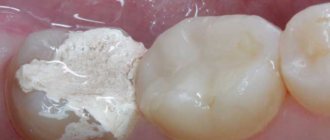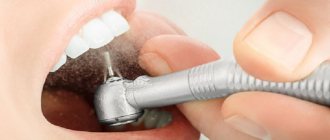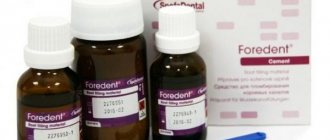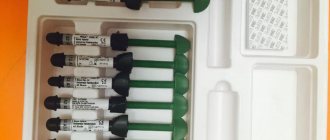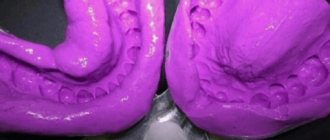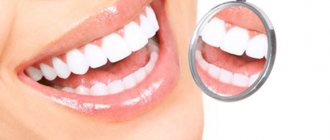7565
In modern dental practice, many new generation materials with high performance and aesthetic characteristics are used.
Composites are no exception. One of the nanomaterials used for the restoration of carious cavities is an American development - Filtek light polymer.
general information
Filling material Filtek belongs to the category of light-curing restoration nanocomposites, which have high strength characteristics and an aesthetic appearance.
This allows the substance to be used both to restore the integrity of the chewing elements of a row, and for the purpose of artistic restoration of teeth included in the smile zone.
Sets of filling materials may include many different colors of the substance , including standard tones intended for the body of the tooth, as well as dentin, enamel and transparent shades.
Thanks to this chameleon effect, the filling does not stand out against the background of your own teeth, and the X-ray contrast of the material helps to accurately determine its location in the tooth surface.
Fixation of Filtek fillings in the cavity is carried out using adhesive systems produced by the manufacturer of the material - the American company 3M ESPE.
Types of Filtek filling material:
There are three types of Filtek fillings: Filtek Z250, Filtek Supreme and Filtek Ultimate.
So, the first one: Filtek Z250 - this material has good density, which allows it to adhere well to the edges of the teeth. This material is used in the so-called layer-by-layer technique, which means the moment when the filling is built up and more than one layer is used. This material minimizes the recurrence of caries to almost zero.
Second: Filtek SupremeXT - this material is great for making veneers or inlays. This material has a large number of shades, which makes it an excellent option for the restoration of front teeth.
And finally the third type: Filtek Ultimate - this material is newer, it was developed to improve and improve the Filtek Supreme material. It's essentially the same thing, but it has an improved formula for long-lasting shine. This material is also more convenient for the dentist to use, which will make the procedure faster.
Release form and composition
The Filtek nanocomposite contains polymer resins: BIS-EMA, BIS-GMA, UDMA, PEGDMA, TEGDMA, as well as an inorganic filler that gives the filling a certain color.
The following substances can be used for filling:
- non-agglomerated silicon filler with a particle size of 20 nm;
- non-agglomerated zirconium filler , the particle size of which ranges from 4 to 11 nm;
- dispersed zirconium-silicon cluster filler.
The fullness of the material may differ depending on its color variety: in translucent shades it is 72.5%, and in enamel and dentin shades it reaches 78.5%.
The filling material is packaged in standard syringes, the quantity of which may vary in different composite configurations.
Special properties of glass ionomer cement for dental fillings and manufacturers’ proposals.
Visit here to learn more about the Spectrum filling.
At this address https://zubovv.ru/lechenie/zubyi/plombyi/harakteristika-tsementnoy.html you will find reviews about cement fillings.
Single Shade Set
Single Shade is an introductory set for restoration with tones of one degree of transparency.
It consists of two 4-gram syringes with Body shades - A2 and A3, designed to restore the body of the tooth.
These types of composite have a slight degree of transparency and are used for single-color restorations.
In addition to syringes with the composite, the kit contains technical instructions for the correct use of the material.
Dual Shade Kit
The Dual Shade set is also intended to introduce composites, but contains the material in two levels of transparency.
The kit includes the following components:
- 1 syringe each of dentin shades A3 and A4;
- 1 syringe each in enamel shades A2 and A3;
- a special selector scale for selecting the shade of the composite;
- instructions for use of the kit components.
Professional set
The professional set includes 12 syringes with different shades of the composite:
- 3 dentin colors – A2, A3 and B3;
- 4 Body shades – A2, A3, A3.5, B2;
- 4 enamel tones – A1, A2, A3, and W;
- 1 transparent shade – AT.
Along with the composite, the kit contains instructions for using the material and a special scale for determining the shade of the substance.
Filtek Z250
The Filtek Z250 composite is a microhybrid substance, which contains the following types of organic resins: BIS-EMA, BIS-GMA, UDMA.
Surface-modified particles of silicon and zirconium with a size of 0.5-5 microns are used as a filler. The mass fraction of filler reaches 60% of the total volume.
The composite has 15 different shades, which are not divided into varieties, unlike the Ultimate mass.
Filtek Z250 sealing compound has the following characteristics:
- high density ensuring good marginal fit;
- elasticity;
- wear resistance;
- low shrinkage;
- aesthetics.
The Filtek Z250 kit contains 8 syringes with a variety of shades, Adper Single Bond adhesive, special etching gel, a set of Sof-Lex discs, as well as a color selection scale and technical instructions.
Nanohybrid Z550
The filling composite FiltekZ550 is a highly filled material, which contains nanometers up to 5 microns in size and associated particles - nanoclusters, whose diameter does not exceed 10 nm. The photopolymer color range contains 12 shades .
The advantages of the nanohybrid are the following characteristics:
- high degree of adaptation to the walls of the carious cavity;
- good modelability;
- retention of shape until polymerization;
- strength and wear resistance.
The material can be used for the restoration of chewing and frontal elements of the row, however, according to experts, in appearance it is somewhat inferior to the Ultimate series.
From the video, learn about the new filling material from 3M ESPE.
Filtek Z250
Filling material 3M ESPE Filtek Z250 belongs to microhybrid composites. It is also used to fill all types of cavities.
Differences in composition
The composite is also based on organic resin. Unlike the Ultimate series, only bis-GMA, UDMA and bis-EMA can be found in the composition.
In addition to the matrix, the Z250 series has a different filler. It contains particles 0.5-5 microns in size.
Release form: 4 g syringe. The number of color options is much smaller; there is no division into dentin, enamel and “body”.
Differences in properties
This material also has the basic properties of composites, namely:
- satisfactory aesthetics;
- wear resistance;
- radiopacity;
- long-term preservation of the quality of the filling.
But due to the different size of the filler, the material has some disadvantages compared to the Ultimate series:
- higher shrinkage during polymerization;
- more complex application of material and its insufficient density;
- the quality of the restoration itself is lower;
- worse polishability;
- insufficient strength when used on complex and multi-level cavities.
Indications, methods of use and precautions are similar to the previous substance.
Advantages
The light-curing Filtek composite has a large number of advantages, which ensure the creation of a durable and aesthetic filling:
- excellent handling properties, guaranteeing dense filling of the carious cavity and a clear fit of the material to its edges;
- high wear resistance and strength to withstand chewing loads;
- low degree of composite shrinkage;
- good polishability;
- a wide color spectrum and the presence of materials of varying degrees of transparency, which allows for multi-layer restorations;
- radiopacity;
- long-term preservation of color and shine.
Material properties
According to the classification, Filtek Ultimate belongs to nanocomposites. The main properties of this filling material are:
- low shrinkage after light curing;
- excellent strength;
- sufficient wear resistance;
- plastic;
- easy adaptation to carious cavity;
- good packability;
- good polishability;
- long-term preservation of surface gloss;
- "chameleon" effect.
Indications for use
Filtek composites can be used if it is necessary to perform the following manipulations:
- restoration of all types of carious cavities according to Black on the frontal and chewing elements of the row;
- aesthetic restoration of teeth included in the smile zone;
- performing indirect restorations : fixing inlays, veneers, onlays;
- splinting teeth;
- superstructure of the stump for further orthopedic treatment;
- restoration using sandwich technology.
Evaluate the result of restoration of the front teeth with light fillings using the patient’s photo before and after the procedure.
In this publication we will tell you how much a tooth hurts after root canal cleaning.
Here https://zubovv.ru/lechenie/zubyi/plombyi/pochemu-bolit-posle-kanalov.html let’s find out together why the tooth hurts after filling.
Preparatory activities
For high-quality installation of a seal and its long-term operation, careful preparation is required, including the following activities:
- Sanitation of the patient's oral cavity. This stage allows you to determine the presence of concomitant diseases of the elements of the series and identify existing contraindications to filling.
- Professional teeth cleaning. Careful removal of plaque helps to correctly determine the color of the tooth and the shade of the future filling, and also ensures a tighter fit of the material to the tissue.
- Determining the color of the filling. To accurately identify the shade of the future filling, the dental plate is divided into three parts - the cervical area, the middle part and the incisal edge.
The optimal color is selected for each area. In the neck area, material of yellowish tones is used, the middle is restored using yellowish, brownish or gray shades.For the cutting edge, blue or gray tones are used. The color saturation and transparency of the filling will depend on the amount of composite applied.
- Test application of material. After determining the color of the filling, a small amount of composite is applied to the tooth surface, polymerized, and the resulting shade is assessed. The manipulation is repeated until the most accurate color is obtained.
- Isolation of teeth. The elements of the row that will be filled are separated from the remaining teeth using a rubber dam or cotton rolls.
Preparation for using the composite
Initially, teeth are cleaned using a brush and toothpaste, then sanitation and professional cleaning are done.
Then you need to choose the color of the future filling. For these purposes, the standard VITA scale is used. To choose the right shade, you need to follow the following recommendations:
- Since the color of the tooth is not uniform, it is divided into 3 parts, each of which has an individual shade. Restoration in the cervical area should be made of a material that has a yellow tint. The middle part is restored from grey, yellow or brown colors. The cutting edge should be made of gray or blue shades.
- The color saturation of the resulting restoration depends on the amount of material used. The smaller it is, the more transparent the filling will be. Depending on the volume of tissue that needs to be restored, the shade is selected. You can select it in that part of the scale that matches the thickness of the future filling.
- After this, part of the material is taken and applied to the place where the dental procedure will be performed. The composite is polymerized, and its shade is assessed under different light sources. You can repeat this step until an acceptable color match is achieved.
The final stage is to isolate the working area with a rubber dam or cotton rollers.
These steps must be followed regardless of the type of restoration.
Restoration methods
Restoring the integrity of the elements of the jaw arch can be carried out using direct or indirect restoration techniques.
The choice of a specific type of procedure is made by a specialist based on clinical data, in particular, the degree of damage to the tooth surface.
Direct recovery
Dental restoration using the direct technique is carried out as follows:
- Preparation of a carious cavity. Dead tissue is removed from the affected hole using standard cavity treatment techniques.
- Pulp protection. When the pulp is exposed, calcium hydroxide and spacer material are applied.
- Fixation of the matrix, etching of enamel, application of adhesive and polymerization. To avoid problems at this stage, you should follow the recommendations of the manufacturer of the materials used.
- Composite preparation. The required amount of photopolymer is squeezed out of the syringe onto a special mixing bar, after which the syringe is closed with a cap, and the extracted gel is protected from sunlight.
- Application of filling agent and polymerization. The material is introduced into the cavity layer by layer, carefully distributed throughout it.
Each layer is light-polymerized using a special lamp. The duration of light exposure depends on the type and transparency of the shade used. - Contouring of the filling. The cured composite is processed using burs or finishers, after which the occlusion is determined using carbon paper. If necessary, excess material is carefully removed with a special tool.
- Polishing. The surface of the filling is ground and polished, after which the restoration is considered complete.
Indirect technique
To indirectly restore the integrity of the tooth, the dentist performs the following measures:
- Prepares the tooth according to accepted manipulation techniques.
- Takes an impression of the processed element of the jaw row and transfers it to the laboratory, where a plaster model is made.
In the dental laboratory the following manipulations are performed:
- the prepared impression is filled with plaster;
- the model is separated from the impression and fixed in the articulator;
- a separator is applied to the separated model of the prepared tooth to facilitate further removal of the finished product;
- the composite material is applied layer by layer and polymerized in accordance with the manufacturer’s instructions;
- Excess filling material is removed , tubercles and tooth ridges are formed;
- the prosthesis is removed from the model , inspected and adjusted if necessary, after which it is polished and transferred to the dental office for fixation to the patient.
After receiving the finished prosthesis, the dentist gives its inner surface the necessary roughness, thoroughly cleans it, rinses and dries it, and secures it in the patient’s oral cavity using special cement.
Recommendations and warnings
The presence of polymer resins in the Filtek composite requires careful handling of the material. It is necessary to ensure that the substance does not come into contact with the skin , so manufacturers recommend carrying out the filling procedure with gloves and carefully isolating the soft tissues of the patient’s oral cavity.
If the composite comes into accidental contact with your skin, you should immediately wash your hands with plenty of water. Contact of a substance with a glove requires removal of the glove, washing of hands with soap and use of a new pair of gloves.
Filtek filling material must be stored in tightly closed syringes for 3 years from the date of manufacture.
To ensure that the quality characteristics of the drug are preserved, exposure to direct sunlight should be avoided.
Nanohybrid Z550
This type of composite belongs to nanohybrid materials.
Differences in composition
Filtek Z550 contains particles with a size of 0.5-5 microns and nanoclusters with a diameter of 0.6-10 nm. It is based on the same polymer resins as the Ultimate material.
Release form – syringe 4 g.
Differences in properties
The 550 series is a modification of the Z250 series. It differs from it in the presence of nanoparticles added to the composition, which improved some of its indicators:
- strength has become higher;
- improved wear resistance;
- insertion into the cavity has become easier and more convenient;
- modeling the filling surface has become easier.
But still, the content of miniparticles does not allow the Z550 to have the same high level of aesthetics as the Ultimate series. In addition, high shrinkage remains after polymerization of the material. The degree of polishability of the material also differs. For this composite it will be slightly lower.
Indications for use, precautions and methods of use correspond to previous photopolymers.
Price
The price of the Filtek composite material depends on the kit’s configuration , so for the Single Shade and Dual Shade packages a specialist will have to pay from 10 to 12 thousand rubles. A professional kit will cost 24-27 thousand rubles.
The cost of a Filtek filling for a patient depends on the volume of restoration performed. So, restoring the surface of one tooth will require 1500-1650 rubles. For the restoration of two surfaces you will have to pay about 1750-1900 rubles.
Reviews
Most dentists speak positively about Filtek composite filling material.
They note the high strength, plasticity and manipulation properties of this preparation, as well as good aesthetic properties, allowing restoration of both molars and frontal elements of the row.
If you have experience using fillings made from Filtek material, share your impressions in the comments section of the article.
If you find an error, please select a piece of text and press Ctrl+Enter.
Tags fillings fillings Filtek
Did you like the article? stay tuned

